 Search by Keyword
Sign Up Below for our MONTHLY BEATLES TRIVIA QUIZ!
|
 "I Feel Fine" picture sleeve
|
"I FEEL FINE"
(John Lennon - Paul McCartney)
 Confidence is considered the foundation for success. For instance, John Lennon introduced their newly written song "I Want To Hold Your Hand" to producer George Martin by saying "You'd better come on down here and have a listen to our next #1 record." His confidence led directly to the success of that song, which not only shot to #1 in Britain but was the crucial track that broke them in America and sky-rocketed them to international fame. Confidence is considered the foundation for success. For instance, John Lennon introduced their newly written song "I Want To Hold Your Hand" to producer George Martin by saying "You'd better come on down here and have a listen to our next #1 record." His confidence led directly to the success of that song, which not only shot to #1 in Britain but was the crucial track that broke them in America and sky-rocketed them to international fame.
 But, it doesn't always work that way. A different example is when The Beatles were scrambling to find a song that was good enough to release as an end-of-the-year single for 1964. Lennon explains: "Going into the studio one morning I said to Ringo, 'I've written this song but it's lousy,' but we tried it, complete with riff, and it sounded like an a-side, so we decided to release it just like that." But, it doesn't always work that way. A different example is when The Beatles were scrambling to find a song that was good enough to release as an end-of-the-year single for 1964. Lennon explains: "Going into the studio one morning I said to Ringo, 'I've written this song but it's lousy,' but we tried it, complete with riff, and it sounded like an a-side, so we decided to release it just like that."
 The song John was describing above was "I Feel Fine," which wound up ending 1964 with a great big bang! It spent five weeks at #1 in Britain and, after their previous three American singles failed to crack the Top 10 (see "I'll Cry Instead," "And I Love Her" and "Matchbox"), this song catapulted them back to #1 on the American charts for three weeks. Even the single's b-side "She's A Woman" peaked at #4 on the Billboard Hot 100, their highest b-side charting yet. Nearly every future Beatles single released after this in the US during their career also made it to the top spot. The song John was describing above was "I Feel Fine," which wound up ending 1964 with a great big bang! It spent five weeks at #1 in Britain and, after their previous three American singles failed to crack the Top 10 (see "I'll Cry Instead," "And I Love Her" and "Matchbox"), this song catapulted them back to #1 on the American charts for three weeks. Even the single's b-side "She's A Woman" peaked at #4 on the Billboard Hot 100, their highest b-side charting yet. Nearly every future Beatles single released after this in the US during their career also made it to the top spot.
 So, in this case, John's uncertainty about "I Feel Fine" led to pulling them out of a slight lull in their American success and cementing them in the #1 spot on the Billboard Hot 100 for the next six years. I guess the song wasn't quite as "lousy" as John originally thought! So, in this case, John's uncertainty about "I Feel Fine" led to pulling them out of a slight lull in their American success and cementing them in the #1 spot on the Billboard Hot 100 for the next six years. I guess the song wasn't quite as "lousy" as John originally thought!
Songwriting History
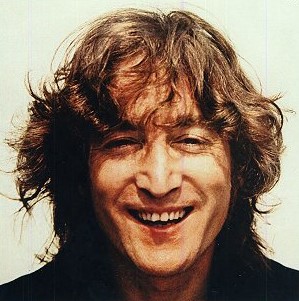 There are many quotes from the individual Beatles regarding the songwriting origins of "I Feel Fine." As usual, some of them are contradictory, as are John's above quote about "going into the studio one morning" with this song already written as compared to his 1974 interview where he claims "I wrote this at a recording session." Paul also claims partial credit for the song, stating in his book "Many Years From Now": "The song itself was more John's than mine. We sat down and co-wrote it with John's original idea." There are many quotes from the individual Beatles regarding the songwriting origins of "I Feel Fine." As usual, some of them are contradictory, as are John's above quote about "going into the studio one morning" with this song already written as compared to his 1974 interview where he claims "I wrote this at a recording session." Paul also claims partial credit for the song, stating in his book "Many Years From Now": "The song itself was more John's than mine. We sat down and co-wrote it with John's original idea."
 One thing that is for certain is that it was based on a guitar riff from a favorite song of Lennon's. "The guitar riff was actually influenced by a record called 'Watch Your Step' by Bobby Parker," George Harrison explained in interview. "But all riffs in that tempo have a similar sound. John played it, and all I did was play it as well, and it became the double-tracked sound." Lennon elaborated, "'Watch Your Step' is one of my favorite records. The Beatles have used the lick in various forms. The Allman Brothers used the lick straight as it was," as evidenced in their song "One Way Out." The Beatles were quite familiar with "Watch Your Step," as they included it in their live performances during 1961 and 1962. One thing that is for certain is that it was based on a guitar riff from a favorite song of Lennon's. "The guitar riff was actually influenced by a record called 'Watch Your Step' by Bobby Parker," George Harrison explained in interview. "But all riffs in that tempo have a similar sound. John played it, and all I did was play it as well, and it became the double-tracked sound." Lennon elaborated, "'Watch Your Step' is one of my favorite records. The Beatles have used the lick in various forms. The Allman Brothers used the lick straight as it was," as evidenced in their song "One Way Out." The Beatles were quite familiar with "Watch Your Step," as they included it in their live performances during 1961 and 1962.
 Writing songs based around guitar riffs was apparently John's latest obsession. "I wrote 'I Feel Fine' around that riff going on in the background," Lennon stated in 1964. "I tried to get that effect into practically every song on the LP, but the others wouldn't have it. I told them I'd write a song especially for the riff. So they said, 'Yes, you go away and do that,' knowing that we'd almost finished the album." Writing songs based around guitar riffs was apparently John's latest obsession. "I wrote 'I Feel Fine' around that riff going on in the background," Lennon stated in 1964. "I tried to get that effect into practically every song on the LP, but the others wouldn't have it. I told them I'd write a song especially for the riff. So they said, 'Yes, you go away and do that,' knowing that we'd almost finished the album."
 As for the time of its writing, John's comment about the song being written "at a recording session" may very well be true, but not at the same recording session that the song was recorded. During the October 6th, 1964 session when The Beatles recorded "Eight Days A Week," John was already going over the distinctive guitar riff of "I Feel Fine," which can be heard in between takes. Therefore, McCartney must have gotten together with John to finish off the song sometime between October 6th and October 18th, 1964, when it was actually recorded. One thing that is for certain is that it was primarily John's song with a little help from Paul, most likely on the bridge. As for the time of its writing, John's comment about the song being written "at a recording session" may very well be true, but not at the same recording session that the song was recorded. During the October 6th, 1964 session when The Beatles recorded "Eight Days A Week," John was already going over the distinctive guitar riff of "I Feel Fine," which can be heard in between takes. Therefore, McCartney must have gotten together with John to finish off the song sometime between October 6th and October 18th, 1964, when it was actually recorded. One thing that is for certain is that it was primarily John's song with a little help from Paul, most likely on the bridge.
Recording History
 October 18th, 1964 had proved to be a marathon recording session for The Beatles, since it was quite apparent that they needed to complete a good number of songs to fill a new album and single before the end of the year. Therefore, they met in EMI Studio Two from 2:30 to 11:30 pm on this day, the result being the completion of eight songs, five of which were quickly-recorded cover versions. October 18th, 1964 had proved to be a marathon recording session for The Beatles, since it was quite apparent that they needed to complete a good number of songs to fill a new album and single before the end of the year. Therefore, they met in EMI Studio Two from 2:30 to 11:30 pm on this day, the result being the completion of eight songs, five of which were quickly-recorded cover versions.
 After putting the finishing touches on "Eight Days A Week" and fully recording "Kansas City / Hey-Hey-Hey-Hey!" and "Mr. Moonlight," they started preparing for the next song, the newly written original composition "I Feel Fine." Geoff Emerick, the 2nd engineer at this session, relates what happened next: "As the band began rehearsing their next song in the studio with George Martin, I used the opportunity to sit in the control room and relax for a few minutes. I was making small talk with Norman (Smith, 1st engineer at this session) about something or other when all of a sudden I heard this loud, buzzing sound issue forth from the speakers." After putting the finishing touches on "Eight Days A Week" and fully recording "Kansas City / Hey-Hey-Hey-Hey!" and "Mr. Moonlight," they started preparing for the next song, the newly written original composition "I Feel Fine." Geoff Emerick, the 2nd engineer at this session, relates what happened next: "As the band began rehearsing their next song in the studio with George Martin, I used the opportunity to sit in the control room and relax for a few minutes. I was making small talk with Norman (Smith, 1st engineer at this session) about something or other when all of a sudden I heard this loud, buzzing sound issue forth from the speakers."
 "'What the bloody hell was that?' I asked him, alarmed," Geoff Emerick continued. "My first thought was that a cable had gone bad, or that a piece of equipment had failed. Norman (Smith) chuckled. 'Have a look,' he said to me. I pressed my nose up against the control room glass and was astonished to see John Lennon kneeling before his amplifier, guitar in hand. We knew that if you brought a guitar too close to an amplifier, it would squeal, but John was using it in a controlled way for the first time." "'What the bloody hell was that?' I asked him, alarmed," Geoff Emerick continued. "My first thought was that a cable had gone bad, or that a piece of equipment had failed. Norman (Smith) chuckled. 'Have a look,' he said to me. I pressed my nose up against the control room glass and was astonished to see John Lennon kneeling before his amplifier, guitar in hand. We knew that if you brought a guitar too close to an amplifier, it would squeal, but John was using it in a controlled way for the first time."
The squeal mentioned above is, of course, the sound heard at the beginning of "I Feel Fine," the explanation of which has become legendary and has been related from many sources in many ways. Early quotes from The Beatles made most think that this was a pure accident that happened during the recording of the song and was kept on the record. While this makes for an interesting story, it simply was not the case.
 In his book "Here, There And Everywhere," Geoff Emerick gives us an interesting detail that clarifies the origin of the introductory sound on the record. "Norman (Smith) later explained to me that they had discovered that sound purely by accident at a previous session, the night they recorded 'Eight Days A Week.' It was just serendipity: during a break, John had leaned his guitar against his amp, but had neglected to turn down the volume of the pickup. Just at that moment, for no particular reason, Paul had plucked a low 'A' on his bass and, from across the room, the sound waves set John's guitar feeding back. They loved the resultant howling, so much so that Lennon had apparently been fooling around with the effect ever since. And with his new song, entitled 'I Feel Fine,' he was determined to immortalize the sound on record...years before Jimi Hendrix ever started doing it." In his book "Here, There And Everywhere," Geoff Emerick gives us an interesting detail that clarifies the origin of the introductory sound on the record. "Norman (Smith) later explained to me that they had discovered that sound purely by accident at a previous session, the night they recorded 'Eight Days A Week.' It was just serendipity: during a break, John had leaned his guitar against his amp, but had neglected to turn down the volume of the pickup. Just at that moment, for no particular reason, Paul had plucked a low 'A' on his bass and, from across the room, the sound waves set John's guitar feeding back. They loved the resultant howling, so much so that Lennon had apparently been fooling around with the effect ever since. And with his new song, entitled 'I Feel Fine,' he was determined to immortalize the sound on record...years before Jimi Hendrix ever started doing it."
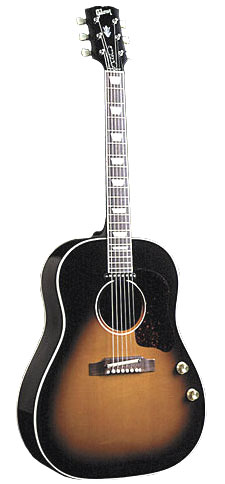 Paul's eye-witness account sheds a little more light on this subject. "John had a semi-acoustic Gibson guitar. It had a pick-up on it so it could be amplified...We were just about to walk away to listen to a take when John leaned his guitar against the amp. I can still see him doing it. He really should have turned the electric off. It was only on a tiny bit, and John just leaned it against the amp when it went, 'Nnnnnnwahhhhh!' And we went, 'What's that? Voodoo!' 'No, it's feedback.' 'Wow, it's a great sound!' George Martin was there so we said, 'Can we have that on the record?' 'Well, I suppose we could, we could edit in on the front.' It was a found object, an accident caused by leaning the guitar against the amp." Paul's eye-witness account sheds a little more light on this subject. "John had a semi-acoustic Gibson guitar. It had a pick-up on it so it could be amplified...We were just about to walk away to listen to a take when John leaned his guitar against the amp. I can still see him doing it. He really should have turned the electric off. It was only on a tiny bit, and John just leaned it against the amp when it went, 'Nnnnnnwahhhhh!' And we went, 'What's that? Voodoo!' 'No, it's feedback.' 'Wow, it's a great sound!' George Martin was there so we said, 'Can we have that on the record?' 'Well, I suppose we could, we could edit in on the front.' It was a found object, an accident caused by leaning the guitar against the amp."
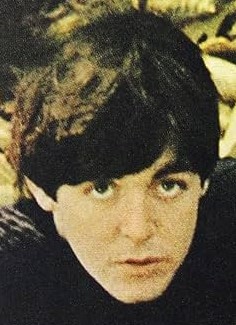 What Paul failed to mention was that this accident occurred during the recording of "Eight Days A Week" and not "I Feel Fine." And it wasn't until twelve days later that The Beatles got their way in including this on a Beatles recording, but it wasn't edited in at all. All of the recorded takes of "I Feel Fine" on October 18th, 1964 started with the well-rehearsed feedback which ushered in John's introductory guitar riff. What Paul failed to mention was that this accident occurred during the recording of "Eight Days A Week" and not "I Feel Fine." And it wasn't until twelve days later that The Beatles got their way in including this on a Beatles recording, but it wasn't edited in at all. All of the recorded takes of "I Feel Fine" on October 18th, 1964 started with the well-rehearsed feedback which ushered in John's introductory guitar riff.
 John was very proud of this accomplishment. "The record had the first feedback anywhere," Lennon claimed in 1980. "I defy anybody to find a record - unless it's some old blues record in 1922 - that used feedback in that way. I mean, everybody played feedback on stage, and the Jimi Hendrix stuff was going on long before (him). In fact, the punk stuff now is only what people were doing in the clubs. So I claim for The Beatles - before Hendrix, before The Who, before anybody - the first feedback on any record." John was very proud of this accomplishment. "The record had the first feedback anywhere," Lennon claimed in 1980. "I defy anybody to find a record - unless it's some old blues record in 1922 - that used feedback in that way. I mean, everybody played feedback on stage, and the Jimi Hendrix stuff was going on long before (him). In fact, the punk stuff now is only what people were doing in the clubs. So I claim for The Beatles - before Hendrix, before The Who, before anybody - the first feedback on any record."
Interestingly, when Paul, George and Ringo are seen on the Anthology film discussing the feedback at the beginning of "I Feel Fine," Harrison jokingly claims that "we invented Jimi Hendrix."
 The Beatles weren't so enthusiastic to explain the real origins of this effect in early interviews because of EMI's strict policies against feedback on released recordings. "It was all a mistake," John explained at the time. "I was standing between Paul's amplifier and mine, and that was the result. But when we heard it, we liked it, so we left it in. Sounds a bit like an electric razor, doesn't it?" The Beatles weren't so enthusiastic to explain the real origins of this effect in early interviews because of EMI's strict policies against feedback on released recordings. "It was all a mistake," John explained at the time. "I was standing between Paul's amplifier and mine, and that was the result. But when we heard it, we liked it, so we left it in. Sounds a bit like an electric razor, doesn't it?"
At approximately 4:30 pm at the October 18th, 1964 recording session, The Beatles recorded their first take of the song. After the feedback was recorded, John was seen having a little trouble singing the song for more than one reason. First of all it was in a key that was too high for him to comfortably sing and, second of all, he found it difficult to sing and play that distinctive riff at the same time. "Take one" broke down after about a minute, resulting in The Beatles remedying at least one of the problems by the time "take two" was attempted.
 "Take two" brought the song down to a lower key which helped John somewhat, but it was still awkward to play and sing simultaneously. They did get through the solo section, but the guitar solo wasn't worked out yet so George just played the riff along with John during this section. Unfortunately, this take also broke down shortly thereafter. "Take two" brought the song down to a lower key which helped John somewhat, but it was still awkward to play and sing simultaneously. They did get through the solo section, but the guitar solo wasn't worked out yet so George just played the riff along with John during this section. Unfortunately, this take also broke down shortly thereafter.
"Take five" appears to be the first complete version of the song, although it still wasn't satisfactory for overdubs. Before "take six" begins, we can hear George Harrison rehearsing the guitar solo he will perform as an overdub a little later. This take shows The Beatles resolving the second issue regarding John's performance, the solution being them just recording a rhythm track without John's vocals, which would then be recorded afterward as an overdub. This take is also complete, but not satisfactory.
 Three attempts later, on "take nine," they performed their best rhythm track, feedback and all. Over this, John recorded his vocals and then double-tracked them as well. Other overdubs include Paul and George doing harmony vocals as well as George's guitar solo. Three attempts later, on "take nine," they performed their best rhythm track, feedback and all. Over this, John recorded his vocals and then double-tracked them as well. Other overdubs include Paul and George doing harmony vocals as well as George's guitar solo.
 Geoff Emerick's eye-witness account of the recording of the song also includes this detail: "Lennon was also more prone to breaking strings than Harrison - he attacked his guitar harder, with less finesse - and I remember that happening several times during the recording of 'I Feel Fine,' which was quite an aggressive, up-tempo song. When that would happen, he would call out, 'Mal! Mal!' Mal (Evans) was usually the one who would change the guitar sings, although on this day he wasn't there, so the task fell to Neil (Aspinal) instead. Neil was physically a lot smaller than his fellow roadie, so everyone had a good laugh when he walked over to take care of the problem and Lennon slowly looked him up and down, finally exclaiming with perfect comic timing, 'Cor, you've shrunk in the wash, Mal!'" Geoff Emerick's eye-witness account of the recording of the song also includes this detail: "Lennon was also more prone to breaking strings than Harrison - he attacked his guitar harder, with less finesse - and I remember that happening several times during the recording of 'I Feel Fine,' which was quite an aggressive, up-tempo song. When that would happen, he would call out, 'Mal! Mal!' Mal (Evans) was usually the one who would change the guitar sings, although on this day he wasn't there, so the task fell to Neil (Aspinal) instead. Neil was physically a lot smaller than his fellow roadie, so everyone had a good laugh when he walked over to take care of the problem and Lennon slowly looked him up and down, finally exclaiming with perfect comic timing, 'Cor, you've shrunk in the wash, Mal!'"
 Three days later, on October 21st, 1964, George Martin and engineers Norman Smith and Ron Pender entered Room 65 at EMI to create four mono mixes of "I Feel Fine." The first two were left unreleased, while the third was prepared for the British single and the fourth was intended for America. The British mix had just a touch of reverb while a little more reverb was added for the American mix, as that was what Capitol Records apparently wanted. This didn't appear to be enough, since it is reported that Capitol added even more. Three days later, on October 21st, 1964, George Martin and engineers Norman Smith and Ron Pender entered Room 65 at EMI to create four mono mixes of "I Feel Fine." The first two were left unreleased, while the third was prepared for the British single and the fourth was intended for America. The British mix had just a touch of reverb while a little more reverb was added for the American mix, as that was what Capitol Records apparently wanted. This didn't appear to be enough, since it is reported that Capitol added even more.
The same EMI staff entered the control room of EMI Studio One the next day, October 22nd, to create a fifth mono mix, although this was never used.
 Even though a stereo mix of the song wasn't required at this time, since it was only slated to be issued as a mono single, a stereo mix was nonetheless made on November 4th, 1964 by George Martin, Norman Smith and 2nd engineer Mike Stone in the control room of EMI Studio Two. This quickly-done mix included a second or two of whispers and quiet noises just before the song begins. While most releases edit this out, the whispers were retained on the British version of the compilation album "The Beatles/1962-1966" (aka "The Red Album"). Even though a stereo mix of the song wasn't required at this time, since it was only slated to be issued as a mono single, a stereo mix was nonetheless made on November 4th, 1964 by George Martin, Norman Smith and 2nd engineer Mike Stone in the control room of EMI Studio Two. This quickly-done mix included a second or two of whispers and quiet noises just before the song begins. While most releases edit this out, the whispers were retained on the British version of the compilation album "The Beatles/1962-1966" (aka "The Red Album").
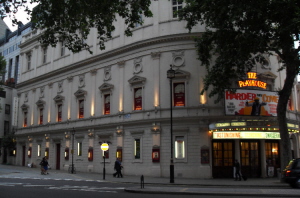 The Beatles also brought "I Feel Fine" to a recording studio for BBC radio on November 17th, 1964, this session being produced by Bernie Andrews at the Playhouse Theatre in London between 7:30 and 11:30 pm. This recording was featured on the radio show "Top Gear" on November 26th, 1964 between 10 am and 12 noon, as well as on the radio show "Saturday Club" on December 26th between 10 am and 12 noon. The session tape from this day shows the group being instructed by producer Bernie Andrews to keep recording attempts of the song until they get it right. Paul and John then try multiple times to get the beginning feedback right and when they do, they proceed to record the entire song. Even though the BBC did not have multi-track tape machines, overdubs could be performed by adding another element while the original recording was copied onto another tape. In the case of "I Feel Fine" on this day, John double-tracked his vocals while a tape copy of the original tape was being made. The Beatles also brought "I Feel Fine" to a recording studio for BBC radio on November 17th, 1964, this session being produced by Bernie Andrews at the Playhouse Theatre in London between 7:30 and 11:30 pm. This recording was featured on the radio show "Top Gear" on November 26th, 1964 between 10 am and 12 noon, as well as on the radio show "Saturday Club" on December 26th between 10 am and 12 noon. The session tape from this day shows the group being instructed by producer Bernie Andrews to keep recording attempts of the song until they get it right. Paul and John then try multiple times to get the beginning feedback right and when they do, they proceed to record the entire song. Even though the BBC did not have multi-track tape machines, overdubs could be performed by adding another element while the original recording was copied onto another tape. In the case of "I Feel Fine" on this day, John double-tracked his vocals while a tape copy of the original tape was being made.
 "I Feel Fine" was put to tape on two other occasions in 1965 during their live performances at the Hollywood Bowl, first on August 29th (produced by Karl Enegmann and engineered by Hugh Davies) and then on August 30th (produced by Voyle Gilmore and engineered by Pete Abbott). Plans were being discussed to release a live album at this time, although it didn't materialize. Seven of the songs recorded on their August 30th show were eventually included on the 1977 "The Beatles At The Hollywood Bowl" album, but "I Feel Fine" was not one of them. "I Feel Fine" was put to tape on two other occasions in 1965 during their live performances at the Hollywood Bowl, first on August 29th (produced by Karl Enegmann and engineered by Hugh Davies) and then on August 30th (produced by Voyle Gilmore and engineered by Pete Abbott). Plans were being discussed to release a live album at this time, although it didn't materialize. Seven of the songs recorded on their August 30th show were eventually included on the 1977 "The Beatles At The Hollywood Bowl" album, but "I Feel Fine" was not one of them.
 A recording session on January 5th, 1966 was scheduled concerning "I Feel Fine," but not at EMI. With a degree of secrecy, The Beatles met that day at CTS Studios in London to fully re-record the song to be dubbed onto the live footage of their Shea Stadium concert on August 15th, 1965. George Martin specifically requested a new full recording of the song because of the bad sound quality of the actual performance. The group had to carefully match their playing and singing with the filmed footage. From watching the film today, the job was done quite convincingly. The results were premiered on American television on January 10th, 1967 as "The Beatles At Shea Stadium." A recording session on January 5th, 1966 was scheduled concerning "I Feel Fine," but not at EMI. With a degree of secrecy, The Beatles met that day at CTS Studios in London to fully re-record the song to be dubbed onto the live footage of their Shea Stadium concert on August 15th, 1965. George Martin specifically requested a new full recording of the song because of the bad sound quality of the actual performance. The group had to carefully match their playing and singing with the filmed footage. From watching the film today, the job was done quite convincingly. The results were premiered on American television on January 10th, 1967 as "The Beatles At Shea Stadium."
 Interestingly, their final live performance on August 29th, 1966 at Candlestick Park included "I Feel Fine," introduced by George by saying it "was recorded about 1959." As detailed in Keith Badman's book "The Beatles Off The Record," the group's press officer Tony Barrow recalls: "There was a sort of end of term spirit thing going on, and there was also this kind of feeling amongst all of us around The Beatles, that this might just be the last concert that they will ever do. I remember Paul, casually, at the very last minute, saying, 'Have you got your cassette recorder with you?' and I said, 'Yes, of course.' Paul then said, 'Tape it, will you? Tape the show,' which I did, literally just holding the microphone up in the middle of the field. As a personal souvenir of the occasion, it was a very nice thing to have." Even though Tony Barrow insists that he only made one copy of the tape, which he had locked in a drawer in his London office, and gave the original to Paul, this recording has been available on bootleg releases throughout the years. Interestingly, their final live performance on August 29th, 1966 at Candlestick Park included "I Feel Fine," introduced by George by saying it "was recorded about 1959." As detailed in Keith Badman's book "The Beatles Off The Record," the group's press officer Tony Barrow recalls: "There was a sort of end of term spirit thing going on, and there was also this kind of feeling amongst all of us around The Beatles, that this might just be the last concert that they will ever do. I remember Paul, casually, at the very last minute, saying, 'Have you got your cassette recorder with you?' and I said, 'Yes, of course.' Paul then said, 'Tape it, will you? Tape the show,' which I did, literally just holding the microphone up in the middle of the field. As a personal souvenir of the occasion, it was a very nice thing to have." Even though Tony Barrow insists that he only made one copy of the tape, which he had locked in a drawer in his London office, and gave the original to Paul, this recording has been available on bootleg releases throughout the years.
 "I Feel Fine" was touched on one last time during a Beatles recording session on January 24th, 1969. After putting in much work on their song "Two Of Us" at Apple Studios during sessions for their "Get Back / Let It Be" project, John began playing "I Feel Fine" on his Epiphone Casino, footage of this appearing in Peter Jackson's 2021 "Get Back" series. "I Feel Fine" was touched on one last time during a Beatles recording session on January 24th, 1969. After putting in much work on their song "Two Of Us" at Apple Studios during sessions for their "Get Back / Let It Be" project, John began playing "I Feel Fine" on his Epiphone Casino, footage of this appearing in Peter Jackson's 2021 "Get Back" series.
 Sometime in 2015, Giles Martin (son of George Martin) and Sam Okell revisited the original master tape of "I Feel Fine" in Abbey Road Studios to create a new stereo mix of the song, the result appearing on a re-release of the compilation album "Beatles 1" that year. Then again in 2023, Giles Martin was given the task of creating a "demix remix" of "I Feel Fine" for inclusion on the 50th Anniversary edition of the compilation album "The Beatles / 1962 - 1966" (aka "The Red Album"). With Peter Jackson's AI technology at his disposal, Giles Martin was able to utilize this "new machine-learning techology" so that "individual elements that were put to tape...and were therefore impossible to separate" could be "untangled, allowing Giles to put the original recordings back together with even greater clarity and impact," as stated by John Harris in the liner notes of the above mentioned album. "The power of Ringo's drumming," Giles Martin explained to Rolling Stone magazine, "it's been unearthed. But the playing is just really good. That's joy." In the case of "I Feel Fine," Ringo's drumming is the absolute highlight of this new mix. Sometime in 2015, Giles Martin (son of George Martin) and Sam Okell revisited the original master tape of "I Feel Fine" in Abbey Road Studios to create a new stereo mix of the song, the result appearing on a re-release of the compilation album "Beatles 1" that year. Then again in 2023, Giles Martin was given the task of creating a "demix remix" of "I Feel Fine" for inclusion on the 50th Anniversary edition of the compilation album "The Beatles / 1962 - 1966" (aka "The Red Album"). With Peter Jackson's AI technology at his disposal, Giles Martin was able to utilize this "new machine-learning techology" so that "individual elements that were put to tape...and were therefore impossible to separate" could be "untangled, allowing Giles to put the original recordings back together with even greater clarity and impact," as stated by John Harris in the liner notes of the above mentioned album. "The power of Ringo's drumming," Giles Martin explained to Rolling Stone magazine, "it's been unearthed. But the playing is just really good. That's joy." In the case of "I Feel Fine," Ringo's drumming is the absolute highlight of this new mix.
 It appears that John Lennon took part in a revival of "I Feel Fine" in the recording studio sometime in August or September of 1980 during the sessions for his classic album "Double Fantasy." Guitarist Earl Slick remembers: "Every once in a while me and Hughie (McCracken) would start playing a Beatles lick and he would chime in and sometimes he wouldn't. I remember we played some of 'I Feel Fine' and a number of other Beatles songs where he'd forgotten the chords or forgot the words." It appears that John Lennon took part in a revival of "I Feel Fine" in the recording studio sometime in August or September of 1980 during the sessions for his classic album "Double Fantasy." Guitarist Earl Slick remembers: "Every once in a while me and Hughie (McCracken) would start playing a Beatles lick and he would chime in and sometimes he wouldn't. I remember we played some of 'I Feel Fine' and a number of other Beatles songs where he'd forgotten the chords or forgot the words."
Song Structure and Style
 The song's structure contains a heavy amount of components due to the brevity of each section. Each of the five verses is only ten measures long, while both bridges are eight measures long. A fourteen measure instrumental section is also featured, as well as an eight measure introduction and a ten measure conclusion. Not including the feedback experiment of undefined length preceding the introduction, what results is an "intro/ verse/ verse/ bridge/ verse/ instrumental/ verse/ bridge/ verse/ outro" structure, which becomes aabacaba minus the intro and outro. The song's structure contains a heavy amount of components due to the brevity of each section. Each of the five verses is only ten measures long, while both bridges are eight measures long. A fourteen measure instrumental section is also featured, as well as an eight measure introduction and a ten measure conclusion. Not including the feedback experiment of undefined length preceding the introduction, what results is an "intro/ verse/ verse/ bridge/ verse/ instrumental/ verse/ bridge/ verse/ outro" structure, which becomes aabacaba minus the intro and outro.
 After the feedback experiment, the length of which was determined by whenever Lennon decided to start playing (the various takes of the song show somewhat different lengths), John introduces the song's guitar riff, which is its most distinctive feature. He starts it off in D, falls down to C, and then hits the home key of G, which signals the band to come in for the last two measures of this eight measure introduction. After the feedback experiment, the length of which was determined by whenever Lennon decided to start playing (the various takes of the song show somewhat different lengths), John introduces the song's guitar riff, which is its most distinctive feature. He starts it off in D, falls down to C, and then hits the home key of G, which signals the band to come in for the last two measures of this eight measure introduction.
 John begins the first ten measure verse with a fast-paced vocal melody line which stays in the home key of G for the first four measures, rising to D on the words "she said so." The verse rounds off with Paul and George harmonizing with John on the key phrase of the song "I'm in love with her and I feel fine," which follows the tried and true formula of ending the verse with the title of the song (see "Love Me Do," "From Me To You" and "And I Love Her" among many others). John begins the first ten measure verse with a fast-paced vocal melody line which stays in the home key of G for the first four measures, rising to D on the words "she said so." The verse rounds off with Paul and George harmonizing with John on the key phrase of the song "I'm in love with her and I feel fine," which follows the tried and true formula of ending the verse with the title of the song (see "Love Me Do," "From Me To You" and "And I Love Her" among many others).
 The second verse comes next, which is a virtual repeat of the preceding verse except for the lyrics of the first four measures. Afterwards, the three part harmony remains intact to usher in the eight measure bridge, which emphasizes the labored half-note melody lines on the words "I'm so glad" and "she's so glad," deviating from the fast moving melody lines heard in the verses. John completes each of the above statements by himself, accentuated by Paul and George's harmonized "ooh" in the background. Ringo also makes the bridge unique by utilizing his trademark sizzling hi-hat, which is only heard during the bridges of the song. The second verse comes next, which is a virtual repeat of the preceding verse except for the lyrics of the first four measures. Afterwards, the three part harmony remains intact to usher in the eight measure bridge, which emphasizes the labored half-note melody lines on the words "I'm so glad" and "she's so glad," deviating from the fast moving melody lines heard in the verses. John completes each of the above statements by himself, accentuated by Paul and George's harmonized "ooh" in the background. Ringo also makes the bridge unique by utilizing his trademark sizzling hi-hat, which is only heard during the bridges of the song.
The bridge takes us comfortably into the third verse to complete the compositional length of the song. This time the ending phrase is altered to "she's in love with me and I feel fine." John then utters a muffled but transitional moan to introduce the instrumental section of the song.
 This fourteen measure instrumental section is actually a composite of two parts, the first being a guitar solo by George in the framework of a verse. After six measures of this, the band drops out, leaving John to repeat the introduction of the song with his descending guitar riff from D to C and then G. When John lands on the first G chord, Ringo signals the band to join in with a full measure syncopated Latin-sounding drum fill. They join in for the final two measures of this instrumental section, which naturally transitions back into a repeat of the second verse. This fourteen measure instrumental section is actually a composite of two parts, the first being a guitar solo by George in the framework of a verse. After six measures of this, the band drops out, leaving John to repeat the introduction of the song with his descending guitar riff from D to C and then G. When John lands on the first G chord, Ringo signals the band to join in with a full measure syncopated Latin-sounding drum fill. They join in for the final two measures of this instrumental section, which naturally transitions back into a repeat of the second verse.
 We complete the original framework of the song with an identical repeat of the bridge and third verse. This final verse is extended by a ten measure conclusion which also is divided into two parts. The first part is a repeat of the final four measures of the verse, re-emphasizing the title of the song in order to drive home this catch phrase as a summary of its message. On the downbeat of the third measure, the band once again disappears to leave John's trademark guitar riff fading off into the sunset. The only other elements of the remaining measures of the song are John's moans (as heard just before the guitar solo), and Paul barking like a dog for some strange reason. We complete the original framework of the song with an identical repeat of the bridge and third verse. This final verse is extended by a ten measure conclusion which also is divided into two parts. The first part is a repeat of the final four measures of the verse, re-emphasizing the title of the song in order to drive home this catch phrase as a summary of its message. On the downbeat of the third measure, the band once again disappears to leave John's trademark guitar riff fading off into the sunset. The only other elements of the remaining measures of the song are John's moans (as heard just before the guitar solo), and Paul barking like a dog for some strange reason.
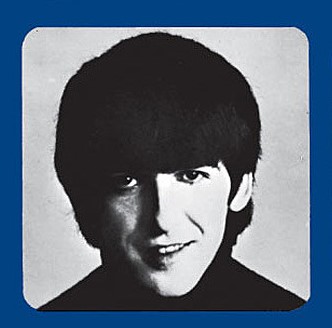 As for musicianship, Lennon is in top form. Fronting the band with his rambling, excellently played guitar riff, he also sings lead with a commanding and convincing tone, comfortable in the song's chosen key. George puts in a pleasing performance as well, mimicking John's acoustic guitar riff on electric guitar to add a richness that makes it distinct from most other Beatles songs to date. Actually, no rhythm instrument is heard at all in the verses of this song, both guitars playing the guitar riff to allow for airiness in the arrangement. The guitar solo is overdubbed on top of both John and George's guitar riff, which touches on the same notes during the fifth and sixth measures to create a surreal effect. Oh yeah, George's harmonies are good too! As for musicianship, Lennon is in top form. Fronting the band with his rambling, excellently played guitar riff, he also sings lead with a commanding and convincing tone, comfortable in the song's chosen key. George puts in a pleasing performance as well, mimicking John's acoustic guitar riff on electric guitar to add a richness that makes it distinct from most other Beatles songs to date. Actually, no rhythm instrument is heard at all in the verses of this song, both guitars playing the guitar riff to allow for airiness in the arrangement. The guitar solo is overdubbed on top of both John and George's guitar riff, which touches on the same notes during the fifth and sixth measures to create a surreal effect. Oh yeah, George's harmonies are good too!
Paul's usual knack for harmonizing  is also evident on this song, as is his excellent bass work which does well to round out the aforementioned airiness in the verses. As for Ringo's drumming, Paul explains: "The drumming is basically what we used to think of as 'What'd I Say' drumming. There was a style of drumming on 'Whad'd I Say' which is sort of Latin R&B that Ray Charles's drummer Milt Turner played on the original record and we used to love it. One of the big clinching factors about Ringo as the drummer in the band was that he could really play that so well." is also evident on this song, as is his excellent bass work which does well to round out the aforementioned airiness in the verses. As for Ringo's drumming, Paul explains: "The drumming is basically what we used to think of as 'What'd I Say' drumming. There was a style of drumming on 'Whad'd I Say' which is sort of Latin R&B that Ray Charles's drummer Milt Turner played on the original record and we used to love it. One of the big clinching factors about Ringo as the drummer in the band was that he could really play that so well."
 Lyrically, the song was written with no pretenses, no misgivings and no doubts about the relationship in question. The moral of the story is simple; "she's in love with me and I feel fine," that is to say, 'my baby loves me and everything is right in the world.' This simple message may have been a throwback to the innocence of earlier Beatle visions like "All I've Got To Do" and "I Want To Hold Your Hand," but in the midst of more recent Lennon-dominated compositions like "I'm A Loser" and "If I Fell," the simple positive message contained in "I Feel Fine" comes across not only convincing, but as a breath of fresh air. Lyrically, the song was written with no pretenses, no misgivings and no doubts about the relationship in question. The moral of the story is simple; "she's in love with me and I feel fine," that is to say, 'my baby loves me and everything is right in the world.' This simple message may have been a throwback to the innocence of earlier Beatle visions like "All I've Got To Do" and "I Want To Hold Your Hand," but in the midst of more recent Lennon-dominated compositions like "I'm A Loser" and "If I Fell," the simple positive message contained in "I Feel Fine" comes across not only convincing, but as a breath of fresh air.
American Releases
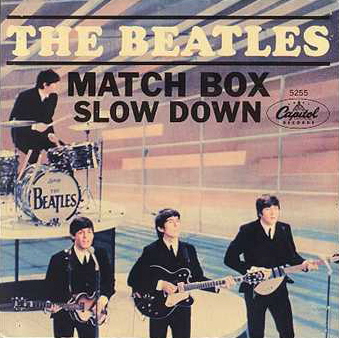 From January 18th, 1964, until October 24th of that year when their song "Matchbox" fell off the charts from #52, The Beatles had at least one song on the American Billboard Hot 100. Within this period of time, 28 different Beatles songs made it onto the chart, which was more than any other artist had ever done (or probably ever will). This included songs recorded by the band as early as 1961 and were released on many American record labels, such as Vee-Jay, Tollie, Atco, MGM and Swan, not to mention Capitol and Capitol Of Canada. From January 18th, 1964, until October 24th of that year when their song "Matchbox" fell off the charts from #52, The Beatles had at least one song on the American Billboard Hot 100. Within this period of time, 28 different Beatles songs made it onto the chart, which was more than any other artist had ever done (or probably ever will). This included songs recorded by the band as early as 1961 and were released on many American record labels, such as Vee-Jay, Tollie, Atco, MGM and Swan, not to mention Capitol and Capitol Of Canada.
 Sadly for US Beatles fans, they were not on the Billboard Hot 100 for five straight weeks in the late autumn of the year. These five long weeks created a restlessness for new Beatles material in the states. Luckily, on November 23rd, 1964, Capitol rush-released the newly acquired Beatles single "I Feel Fine" with "She's A Woman" on the b-side. Even though only a short period of time had gone by, this single was viewed as long overdue. Sadly for US Beatles fans, they were not on the Billboard Hot 100 for five straight weeks in the late autumn of the year. These five long weeks created a restlessness for new Beatles material in the states. Luckily, on November 23rd, 1964, Capitol rush-released the newly acquired Beatles single "I Feel Fine" with "She's A Woman" on the b-side. Even though only a short period of time had gone by, this single was viewed as long overdue.
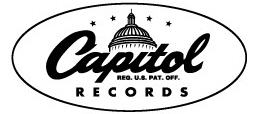 To help create even more demand, Los Angeles radio station KRLA somehow obtained an early copy of this disc on November 6th, 1964 and immediately began playing it on the air once an hour. "We've received calls from Florida, New York, St. Louis, Denver and Cleveland stations," explained KRLA Program Director Reb Foster, "offering us money and queries about where we picked up the single. We don't feel we are (doing anything illegal) in breaking the record." Although apparently no lawsuits were filed, Capitol kindly requested them to discontinue playing the song and asked them not to pass it on to any other radio station. Mysteriously, though, radio station KQV in Pittsburgh played "I Feel Fine" on the air on November 11th, 1964 and passed a copy to WABC in New York, who gave it airplay well before the release date. To help create even more demand, Los Angeles radio station KRLA somehow obtained an early copy of this disc on November 6th, 1964 and immediately began playing it on the air once an hour. "We've received calls from Florida, New York, St. Louis, Denver and Cleveland stations," explained KRLA Program Director Reb Foster, "offering us money and queries about where we picked up the single. We don't feel we are (doing anything illegal) in breaking the record." Although apparently no lawsuits were filed, Capitol kindly requested them to discontinue playing the song and asked them not to pass it on to any other radio station. Mysteriously, though, radio station KQV in Pittsburgh played "I Feel Fine" on the air on November 11th, 1964 and passed a copy to WABC in New York, who gave it airplay well before the release date.
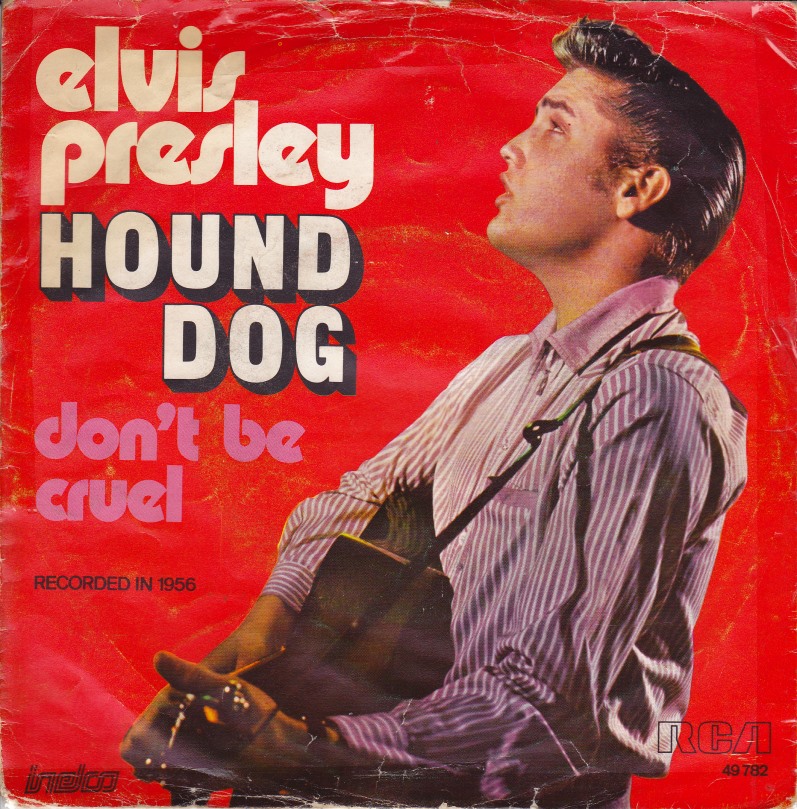 After the highly "reverbed" single was officially released, the response was incredible. It only took four weeks for it to reach the #1 spot on the Billboard Hot 100 (from #22 to #5 to #2 to #1). Since its first of three weeks at the top of the charts was on December 26th, it became The Beatles' sixth US #1 single of 1964. This means that, because of "I Feel Fine," they hold the all-time record of most #1 singles in the same year on the US Billboard Hot 100 chart, even beating Elvis Presley who only had five on the Billboard singles chart in 1956. After the highly "reverbed" single was officially released, the response was incredible. It only took four weeks for it to reach the #1 spot on the Billboard Hot 100 (from #22 to #5 to #2 to #1). Since its first of three weeks at the top of the charts was on December 26th, it became The Beatles' sixth US #1 single of 1964. This means that, because of "I Feel Fine," they hold the all-time record of most #1 singles in the same year on the US Billboard Hot 100 chart, even beating Elvis Presley who only had five on the Billboard singles chart in 1956.
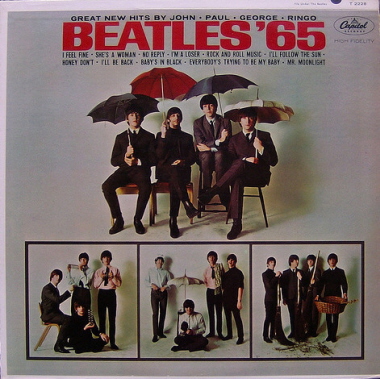 It was only natural for Capitol to include both sides of this current single on their December 15th, 1964 released album "Beatles '65." This highly successful album, which spent nine weeks at #1 on the Billboard album chart, included a "duophonic" (or fake) stereo version of the song on its stereo version, since they hadn't received a stereo mix of the song from Britain. Most listeners agree that this simulated stereo version of the song is a mess, although the mono version of the album contains the "reverbed" version of the song as heard on the American single. Because of the depth of the reverb effect, though, both the mono and stereo US versions accentuate McCartney's dog barks in the fade-out of the song. "Beatles '65" then appeared as an individual compact disc on January 21st, 2014, both the mono and stereo versions of the album contained on a single CD. It was only natural for Capitol to include both sides of this current single on their December 15th, 1964 released album "Beatles '65." This highly successful album, which spent nine weeks at #1 on the Billboard album chart, included a "duophonic" (or fake) stereo version of the song on its stereo version, since they hadn't received a stereo mix of the song from Britain. Most listeners agree that this simulated stereo version of the song is a mess, although the mono version of the album contains the "reverbed" version of the song as heard on the American single. Because of the depth of the reverb effect, though, both the mono and stereo US versions accentuate McCartney's dog barks in the fade-out of the song. "Beatles '65" then appeared as an individual compact disc on January 21st, 2014, both the mono and stereo versions of the album contained on a single CD.
 Sometime in 1967, Capitol released Beatles music on a brand new but short-lived format called "Playtapes." These tape cartidges did not have the capability to include entire albums, so a truncated four-song version of "Beatles '65" was released in this portable format, "I Feel Fine" being one of these songs. These "Playtapes" are all highly collectable today. Sometime in 1967, Capitol released Beatles music on a brand new but short-lived format called "Playtapes." These tape cartidges did not have the capability to include entire albums, so a truncated four-song version of "Beatles '65" was released in this portable format, "I Feel Fine" being one of these songs. These "Playtapes" are all highly collectable today.
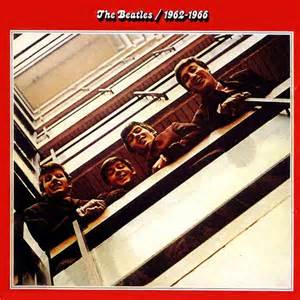 April 2nd, 1973 saw the next release of the song on the double-album compilation "The Beatles/1962-1966" (aka "The Red Album"). While British copies of this album feature the unadulterated stereo mix of the song made on November 4th, 1964, even including a second or two of whispers and sounds before the song begins, US copies still included the usual reverb mix Americans were used to hearing. April 2nd, 1973 saw the next release of the song on the double-album compilation "The Beatles/1962-1966" (aka "The Red Album"). While British copies of this album feature the unadulterated stereo mix of the song made on November 4th, 1964, even including a second or two of whispers and sounds before the song begins, US copies still included the usual reverb mix Americans were used to hearing.
 The next release of the song wasn't until October 11th, 1982, on the compilation album "20 Greatest Hits." Since the US was just becoming engulfed by the MTV generation at that time, this album only managed to reach #50 on the Billboard album chart, quite low for a Beatles release. The next release of the song wasn't until October 11th, 1982, on the compilation album "20 Greatest Hits." Since the US was just becoming engulfed by the MTV generation at that time, this album only managed to reach #50 on the Billboard album chart, quite low for a Beatles release.
 Shortly thereafter, though, the compact disc era began, and with it a desire to hear The Beatles music without the scratches and pops from their turntables. "Past Masters, Volume One" was a compilation album released on March 7th, 1988 on compact disc, the intention being to consolidate all of The Beatles' singles and EP tracks that were not contained on their British albums. On this release, US audiences finally had available to them the stereo mix of "I Feel Fine" without the added reverb, which sounded quite strange at first to American ears. For the vinyl release that came out on October 24th, 1988, a decision was made to combine both volumes of the "Past Masters" series into one double-album. The remastered stereo version was released on September 9th, 2009 under the simplified title "Past Masters," which combined both volumes of the 1988 discs into a 2-CD set, a remastered vinyl set coming out on November 12th, 2012. Shortly thereafter, though, the compact disc era began, and with it a desire to hear The Beatles music without the scratches and pops from their turntables. "Past Masters, Volume One" was a compilation album released on March 7th, 1988 on compact disc, the intention being to consolidate all of The Beatles' singles and EP tracks that were not contained on their British albums. On this release, US audiences finally had available to them the stereo mix of "I Feel Fine" without the added reverb, which sounded quite strange at first to American ears. For the vinyl release that came out on October 24th, 1988, a decision was made to combine both volumes of the "Past Masters" series into one double-album. The remastered stereo version was released on September 9th, 2009 under the simplified title "Past Masters," which combined both volumes of the 1988 discs into a 2-CD set, a remastered vinyl set coming out on November 12th, 2012.
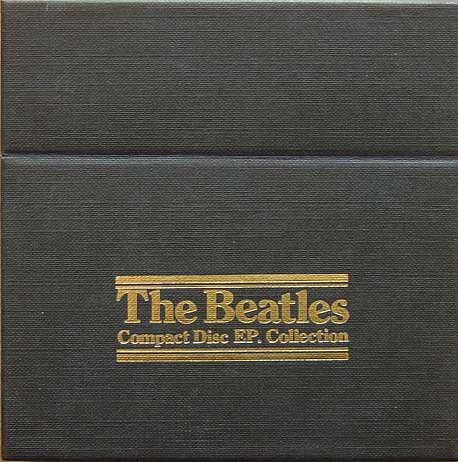 On June 30th, 1992, Capitol released the box set "Compact Disc EP Collection" that included "I Feel Fine" because of its being on the original British EP "The Beatles' Million Sellers." On June 30th, 1992, Capitol released the box set "Compact Disc EP Collection" that included "I Feel Fine" because of its being on the original British EP "The Beatles' Million Sellers."
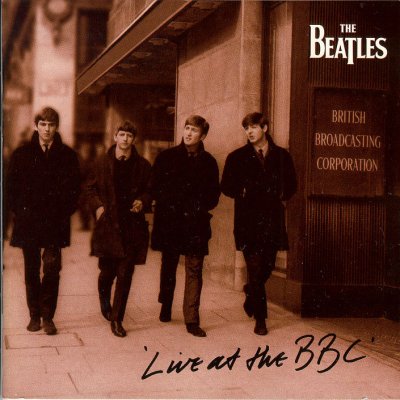 Next came the November 30th, 1994 released double album "Live At The BBC." The Beatles recorded "I Feel Fine" for the BBC radio show "Top Gear" on November 17th, 1964, which was broadcast on November 26th of that year. An interesting account of the recording of this version appears in the liner notes of this album: "The complete BBC session tape of 'I Feel Fine' reveals that the distinctive feedback opening took quite a few attempts to get right and that riff was pretty tricky too!" On November 11th, 2013, this album was remastered, re-packaged and re-released. Next came the November 30th, 1994 released double album "Live At The BBC." The Beatles recorded "I Feel Fine" for the BBC radio show "Top Gear" on November 17th, 1964, which was broadcast on November 26th of that year. An interesting account of the recording of this version appears in the liner notes of this album: "The complete BBC session tape of 'I Feel Fine' reveals that the distinctive feedback opening took quite a few attempts to get right and that riff was pretty tricky too!" On November 11th, 2013, this album was remastered, re-packaged and re-released.
 March 18th, 1996 was the date that the second volume of the Anthology series of albums was released, which was appropriately titled "Anthology 2." A live version of "I Feel Fine" that was recorded on August 1st, 1965 at the ABC Theatre in Blackpool for the television show "Blackpool Night Out" was included on this double CD, which debuted in the top spot of the Billboard album chart. March 18th, 1996 was the date that the second volume of the Anthology series of albums was released, which was appropriately titled "Anthology 2." A live version of "I Feel Fine" that was recorded on August 1st, 1965 at the ABC Theatre in Blackpool for the television show "Blackpool Night Out" was included on this double CD, which debuted in the top spot of the Billboard album chart.
 The biggest selling Beatles album of all time also featured "I Feel Fine." "Beatles 1" was released on November 13th, 2000 and went on to become the biggest selling album of the 2000s in the US and worldwide. With 27 #1 Beatles songs on one inexpensive compact disc, how could you go wrong? A remastered version of this album was released in September of 2011 and a newly mixed version was released on November 6th, 2015. The biggest selling Beatles album of all time also featured "I Feel Fine." "Beatles 1" was released on November 13th, 2000 and went on to become the biggest selling album of the 2000s in the US and worldwide. With 27 #1 Beatles songs on one inexpensive compact disc, how could you go wrong? A remastered version of this album was released in September of 2011 and a newly mixed version was released on November 6th, 2015.
 A further release on November 15th, 2004 brought fans the original "Beatles '65" album back into American homes. "The Capitol Albums, Vol. 1" is a box set that includes the original stereo and mono masters of the four Capitol albums that were originally released in 1964. So if you still prefer the "reverbed" version of "I Feel Fine," you can own it with this release. A further release on November 15th, 2004 brought fans the original "Beatles '65" album back into American homes. "The Capitol Albums, Vol. 1" is a box set that includes the original stereo and mono masters of the four Capitol albums that were originally released in 1964. So if you still prefer the "reverbed" version of "I Feel Fine," you can own it with this release.
On September 9th, 2009, the CD box set "The Beatles In Mono" was released, this featuring the entire mono Beatles catalog in a sparkling remastered condition. The reverb-less "I Feel Fine" is contained on the CD "Mono Masters," which is included in this collection. The vinyl edition of this box set was first released on September 9th, 2014.
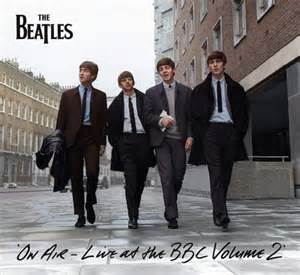 November 11th, 2013 was the release date for the album "On Air - Live At The BBC Volume 2," which featured a quite interesting new version of "I Feel Fine" recorded at the BBC Playhouse Theater in London for the radio program "Top Gear." This unedited session tape from November 17th, 1964, discovered in 1988, features the group recording the song as detailed above under "Recording History." The final result was included on the above mentioned "Live At The BBC" album, while the interesting initial recording is featured here. November 11th, 2013 was the release date for the album "On Air - Live At The BBC Volume 2," which featured a quite interesting new version of "I Feel Fine" recorded at the BBC Playhouse Theater in London for the radio program "Top Gear." This unedited session tape from November 17th, 1964, discovered in 1988, features the group recording the song as detailed above under "Recording History." The final result was included on the above mentioned "Live At The BBC" album, while the interesting initial recording is featured here.
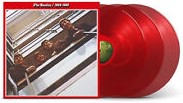 A 50th Anniversay edition of the compilation album "The Beatles / 1962 - 1966" (aka "The Red Album") was released on November 10th, 2023, the new stereo mix of "I Feel Fine," as detailed above, being included. This expanded release included 12 additional songs for a total of 38 tracks, and was made available as a double CD and as a triple vinyl release on both black and red vinyl. A 50th Anniversay edition of the compilation album "The Beatles / 1962 - 1966" (aka "The Red Album") was released on November 10th, 2023, the new stereo mix of "I Feel Fine," as detailed above, being included. This expanded release included 12 additional songs for a total of 38 tracks, and was made available as a double CD and as a triple vinyl release on both black and red vinyl.
 "I Feel Fine" British single
|
Live Performances
The usual practice for The Beatles was to promote both sides of their latest single as much as possible. "I Feel Fine" not only received a lot of exposure around the time of its release but was continually played live by the group right up until they stopped touring in 1966.
 They started off promoting the song on British television on the show "Thank Your Lucky Stars" (renamed "Lucky Stars Special" because of their appearance on the show). They lip-synced the song on November 14th for the show, which was broadcast on November 21st, 1964. Then on November 16th, they mimed the song once again for the TV show "Top Of The Pops," which aired on December 3rd, 1964. Another lip-synced performance of "I Feel Fine" was also taped on November 23rd, 1964 for the British TV show "Ready, Steady, Go!", which was broadcast on November 27th. They started off promoting the song on British television on the show "Thank Your Lucky Stars" (renamed "Lucky Stars Special" because of their appearance on the show). They lip-synced the song on November 14th for the show, which was broadcast on November 21st, 1964. Then on November 16th, they mimed the song once again for the TV show "Top Of The Pops," which aired on December 3rd, 1964. Another lip-synced performance of "I Feel Fine" was also taped on November 23rd, 1964 for the British TV show "Ready, Steady, Go!", which was broadcast on November 27th.
 "I Feel Fine" naturally was included in the set list of their 38 performances (dating from December 24th, 1964 to January 16th, 1965) on the Brian Epstein arranged show "Another Beatles Christmas Show" at the Odeon Cinema in London. After this the group gave the song a three month rest as they concentrated on filming and recording music for their second film "Help!" "I Feel Fine" naturally was included in the set list of their 38 performances (dating from December 24th, 1964 to January 16th, 1965) on the Brian Epstein arranged show "Another Beatles Christmas Show" at the Odeon Cinema in London. After this the group gave the song a three month rest as they concentrated on filming and recording music for their second film "Help!"
They did interrupt their filming schedule to appear in the "New Musical Express 1964-1965 Annual Poll-Winners' All-Star Concert" on April 11th, 1965. Highlights of this show, which featured "I Feel Fine," were broadcast on British television on the show "Poll Winners Concert" on April 18th of that year.
 A brief European tour, which included "I Feel Fine" in their set list, began on June 20th, 1965 at the Palais des Sports in Paris. The entire afternoon performance on this date was taped and broadcast on French radio. The tour progressed through France, Italy and Spain until July 3rd, 1965. A brief European tour, which included "I Feel Fine" in their set list, began on June 20th, 1965 at the Palais des Sports in Paris. The entire afternoon performance on this date was taped and broadcast on French radio. The tour progressed through France, Italy and Spain until July 3rd, 1965.
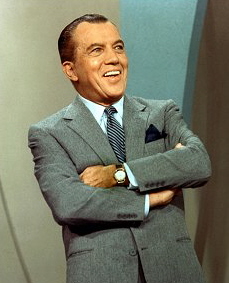 Two television performances of the song were made in August of 1965, the first for the British variety show "Blackpool Night Out," which was a live broadcast on August 1st. Then they taped a performance in New York City for American television on August 14th, their fourth appearance on "The Ed Sullivan Show." This segment wasn't broadcast until September 12th, which was the first program for the new fall season. Two television performances of the song were made in August of 1965, the first for the British variety show "Blackpool Night Out," which was a live broadcast on August 1st. Then they taped a performance in New York City for American television on August 14th, their fourth appearance on "The Ed Sullivan Show." This segment wasn't broadcast until September 12th, which was the first program for the new fall season.
 The second half of August saw The Beatles engage in their second extensive American Tour, which began with the legendary Shea Stadium concert in New York City on August 15th, 1965. With "I Feel Fine" as the third song of their set, they jumped around North America to hot spots in Atlanta, Houston and Toronto - including their Hollywood Bowl concerts in Los Angeles on August 29th and 30th, 1965. The second half of August saw The Beatles engage in their second extensive American Tour, which began with the legendary Shea Stadium concert in New York City on August 15th, 1965. With "I Feel Fine" as the third song of their set, they jumped around North America to hot spots in Atlanta, Houston and Toronto - including their Hollywood Bowl concerts in Los Angeles on August 29th and 30th, 1965.
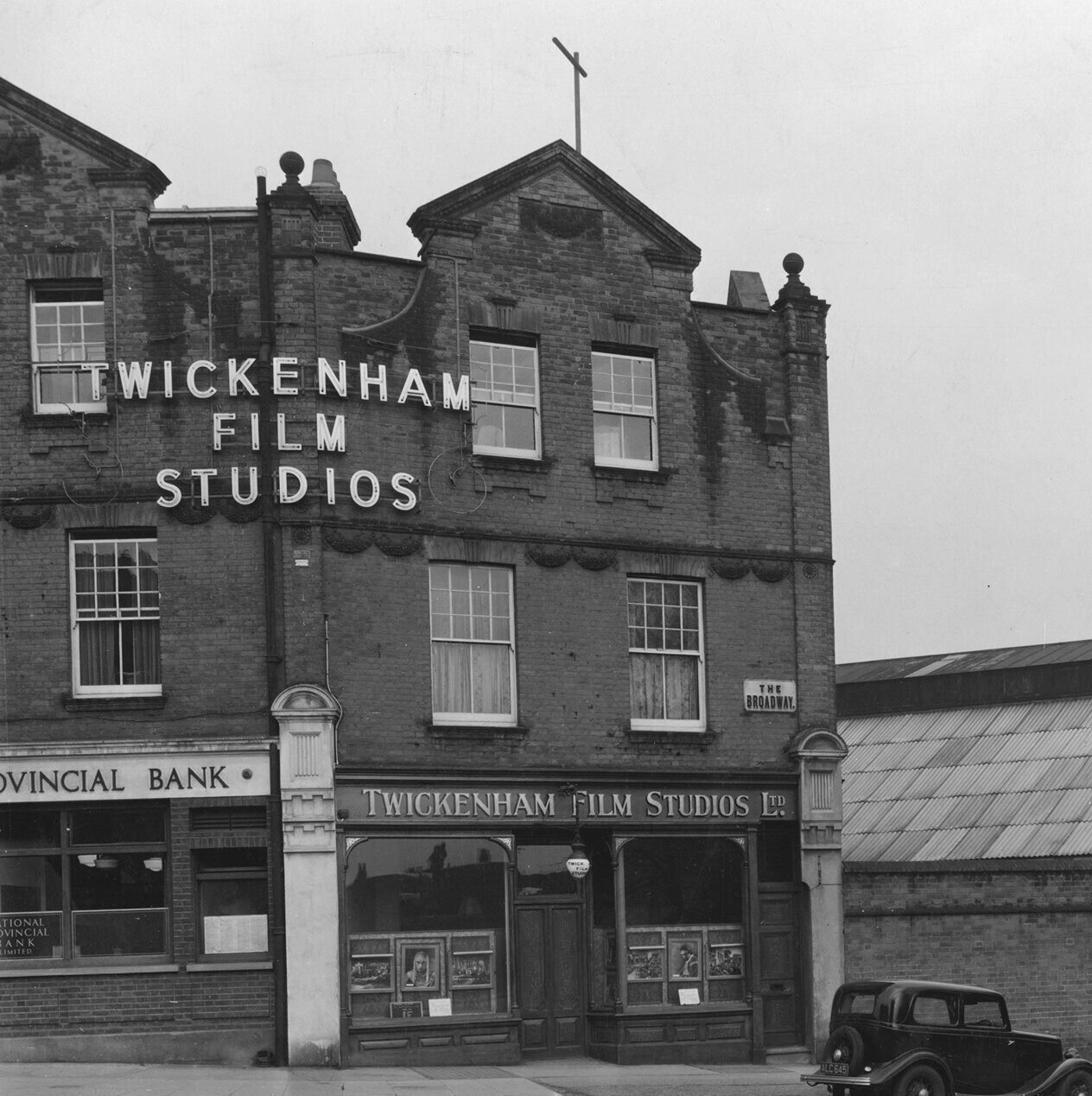 Because The Beatles were ever more reluctant to appear on television shows to promote new singles, they filmed numerous lip-synced videos of a few of their recent singles for distribution to TV stations. They set aside November 23rd, 1965 to enter Twickenham Film Studios to create these films. Curiously, they mimed two off-beat videos for the year old "I Feel Fine," the first of which showed them performing the song amongst exercise equipment (Ringo riding an exercise bike). The second video shows them scarcely even attempting to lip-sync to the song while they all ate newspaper-wrapped fish and chips. The British TV program "Top Of The Pops '65" showed the first clip on both December 25th and 26th, 1965, while the second "fish and chips" video was never shown anywhere, since Brian Epstein was unhappy with the film. Because The Beatles were ever more reluctant to appear on television shows to promote new singles, they filmed numerous lip-synced videos of a few of their recent singles for distribution to TV stations. They set aside November 23rd, 1965 to enter Twickenham Film Studios to create these films. Curiously, they mimed two off-beat videos for the year old "I Feel Fine," the first of which showed them performing the song amongst exercise equipment (Ringo riding an exercise bike). The second video shows them scarcely even attempting to lip-sync to the song while they all ate newspaper-wrapped fish and chips. The British TV program "Top Of The Pops '65" showed the first clip on both December 25th and 26th, 1965, while the second "fish and chips" video was never shown anywhere, since Brian Epstein was unhappy with the film.
 The Beatles then commenced with what became their last British tour, which spanned from December 3rd, 1965 in Glasgow to December 12th, 1965 at the Capitol Cinema in Cardiff. This tour, which included many stops such as London, Manchester, Birmingham and even their last ever concert in Liverpool, began with "I Feel Fine" at the top of the set list. The Beatles then commenced with what became their last British tour, which spanned from December 3rd, 1965 in Glasgow to December 12th, 1965 at the Capitol Cinema in Cardiff. This tour, which included many stops such as London, Manchester, Birmingham and even their last ever concert in Liverpool, began with "I Feel Fine" at the top of the set list.
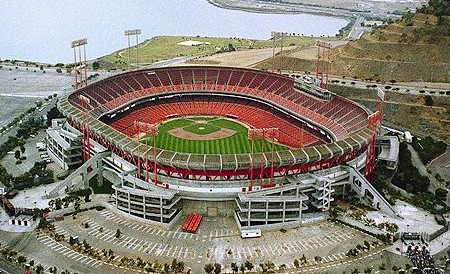 Being comfortable with the song, they continued to perform it throughout 1966, as first evidenced in their final appearance on the "New Musical Express Annual Poll-Winners' All-Star Concert" in Wembley on May 1st of that year. Their brief international concert tour, which ran from June 24th in Munich to the infamous July 4th show in The Philippines, included it as the sixth song in their eleven song set list. Finally, The Beatles third American tour, from August 12th in Chicago to August 29th of that year in San Francisco at Candlestick Park, featured the exact same set list. Therefore "I Feel Fine" was performed at the very last concert they ever performed (other than the Apple rooftop show of January 30th, 1969). Being comfortable with the song, they continued to perform it throughout 1966, as first evidenced in their final appearance on the "New Musical Express Annual Poll-Winners' All-Star Concert" in Wembley on May 1st of that year. Their brief international concert tour, which ran from June 24th in Munich to the infamous July 4th show in The Philippines, included it as the sixth song in their eleven song set list. Finally, The Beatles third American tour, from August 12th in Chicago to August 29th of that year in San Francisco at Candlestick Park, featured the exact same set list. Therefore "I Feel Fine" was performed at the very last concert they ever performed (other than the Apple rooftop show of January 30th, 1969).
Conclusion
 While much can be found in print and in Beatle interviews explaining the origin and originality of the feedback introduction to "I Feel Fine," what shouldn't be overlooked is the driving energy and innocent charm of the song as a whole. The attack of the melodic riff, which is the central figure of the entire song, propels the band through one of their most convincing performances to date. Undeniably this song can be described as a "rocker," but in combination with lyrics that everyone on the planet can relate to, "I Feel Fine" is truly a "feel good" song. While much can be found in print and in Beatle interviews explaining the origin and originality of the feedback introduction to "I Feel Fine," what shouldn't be overlooked is the driving energy and innocent charm of the song as a whole. The attack of the melodic riff, which is the central figure of the entire song, propels the band through one of their most convincing performances to date. Undeniably this song can be described as a "rocker," but in combination with lyrics that everyone on the planet can relate to, "I Feel Fine" is truly a "feel good" song.
Song Summary
"I Feel Fine"
Written by: John Lennon / Paul McCartney
-
Song Written: October 1964
-
Song Recorded: October 18, 1964
-
First US Release Date: November 23, 1964
-
US Single Release: Capitol #5327
-
Highest Chart Position: #1 (three weeks)
-
-
British Album Release: Parlophone #PCS 7016 "A Collection Of Beatles Oldies"
-
Length: 2:25
-
Key: G major
-
Producer: George Martin
-
Engineers: Norman Smith, Geoff Emerick
Instrumentation (most likely):
-
John Lennon - Lead Vocals, Lead/Rhythm Guitar (1964 Gibson J160E)
-
Paul McCartney - Bass Guitar (1963 Hofner 500/1), harmony vocals
-
George Harrison - Lead Guitar (1963 Gretsch 6199 Tennessean), harmony vocals
- Ringo Starr - Drums (1964 Ludwig Super Classic Black Oyster Pearl)
Written and compiled by Dave Rybaczewski
|
IF YOU WOULD LIKE TO MAKE A DONATION TO KEEP THIS WEBSITE UP AND RUNNING, PLEASE CLICK BELOW!
|